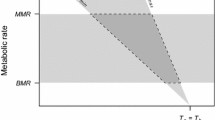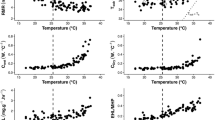Summary
In the present paper we examine the ability of rodents to maintain body temperature (T B ) following the marked reductions in metabolic heat production associated with torpor. Previously published values for metabolic rate (M),T B and ambient temperature (T A ) were used to calculate thermal conductances (C') during normothermy and torpor in rodents capable of daily torpor (11 species) and hibernation (18 species). Values ofC' for torpid animals are uniformly lower thanC' in normothermic animals. In addition,C' of normothermic and torpid rodents decreases with increasing body mass (BM). However, the slope of the relationship betweenC' and BM is almost 4-fold greater for normothermic than for torpid animals. Thus, the ability of torpid rodents to conserve body heat by reducingC' decreases with increasing mass. Rodents that use daily torpor tend to be small and they tend to maintainT B well aboveT A during torpor. Hibernators tend to be larger and regulateT B relatively close toT A . Thus, the reductions inC' appear to be closely correlated with the level ofT B regulation during torpor. We suggest that the changes inC' represent a suite of physiological adaptations that have played a central role in the evolution of torpor, enabling rodents to regulateT B aboveT B during periods of very low heat production. Based on the approach used here we address the controversy of whether reductions inM during torpor are due entirely to temperature effects or whether metabolic inhibition in addition to temperature effects may be important. We suggest that the controversy has been confused by usingQ 10 to evaluate the relationship ofM andT B in endotherms. What is perceived as metabolic inhibition (i.e.,Q 10>3) is confounded by changes in the relationship ofM andT B due to reductions inC' and reductions in the difference betweenT B andT A . Unfortunately, changes inM andT B cannot be used to quantify changes in metabolic state in endotherms. Thus, neitherQ 10 nor the approach used here can be used to make valid statements about the metabolic regulatory processes associated with torpor. Other methods, perhaps at the cell or tissue level, are needed.
Similar content being viewed by others
Abbreviations
- T B :
-
body temperature
- T A :
-
ambient temperature
- C' :
-
thermal conductance
- C ′n :
-
normothermicC ′ whenT A is above a lower critical temperature
- C ′t :
-
torporC ′ when animals are in daily torpor or hibernation
- M :
-
metabolic rate
- BM :
-
body mass
- WVPD :
-
water vapor pressure deficit
References
Aschoff J (1981) Thermal conductance in mammals and birds: its dependence on body size and circadian phase. Comp Biochem Physiol 69 A:611–619
Bakken GS (1976) A heat transfer analysis of animals: unifying concepts and the application of metabolism chamber data to field ecology. J Theor Biol 60:337–384
Barnes BM, Kretzmann M, Licht P, Zucker I (1986) The influence of hibernation on testes growth and spermatogenesis in the golden-mantled ground squirrel,Spermophilus lateralis. Biol Reprod 35:1289–1297
Bartholomew GA (1981) A matter of size: an examination of endothermy in insects and terrestrial vertebrates. In: Heinrich B (Ed) Insect thermoregulation. John Wiley and Sons, New York, pp 45–78
Bartholomew GA, Hudson JW (1960) Aestivation in the mohave ground squirrel,Citellus mohavensis. Bull Mus Comp Zool 124:193–208
Bickler PE (1984) CO2 balance of a heterothermic rodent: comparison of sleep, torpor, and awake states. Am J Physiol 246:R49-R55
Birkebak RC (1966) Heat transfer in biological systems. Int Rev Gen Exp Zool 2:269–344
Brown JH, Bartholomew GA (1969) Periodicity and energetics of torpor in the kangaroo mouse,Microdipodops pallidus. Ecology 50:705–709
Burton AC (1934) The application of the theory of heat flow to the study of energy metabolism. J Nutrition 7:497–533
Butler PH, Jones DR (1982) The comparative physiology of diving in vertebrates. Adv Comp Physiol Biochem 8:179–364
Cranford JA (1983) Body temperature, heart rate and oxygen consumption of normothermic and heterothermic western jumping mice (Zapus princeps). Comp Biochem Physiol A 74:595–599
Deavers DR, Hudson JW (1981) Temperature regulation in two rodents (Clethrinomys gapperi andPeromyscus leucopus) and a shrew (Blarina brevicaudata) inhabiting the same environment. Physiol Zool 54:94–108
Eckert R, Randall D, Augustine G (1988) Animal physiology: mechanisms and adaptations. WH Freeman, New York
Florant G, Heller HC (1977) CNS regulation of body temperature in euthermic and hibernating marmots (Marmota flaviventris). Am J Physiol 232:R203-R208
Florant G, Turner BM, Heller HC (1978) Temperature regulation during wakefulness, sleep, and hibernation in marmots. Am J Physiol 235:R82-R88
French AR (1982) Effects of temperature on the duration of arousal episodes during hibernation. J Appl Physiol 52:216–220
Geiser F (1986) Temperature regulation in heterothermic marsupials. In: Heller HC, Musacchia XJ, Wang LCH (eds) Living in the cold. Elsevier, New York, pp 207–212
Geiser F (1988) Reduction of metabolism during hibernation and daily torpor in mammals and birds: temperature effect or physiological inhibition? J Comp Physiol B 158:25–37
Geiser F, Kenagy GJ (1987) Polyunsaturated lipid diet lengthens torpor and reduces body temperature in a hibernator Am J Physiol 252:R897-R901
Hammel HT, Heller HC, Sharp FR (1973) Probing the rostral brain stem of anaesthetized, unaesthetized and exercising dogs and of hibrrnating and euthermic ground squirrels. Fed Proc 32:1588–1597
Heldmaier G, Steinlechner S (1981a) Seasonal pattern and energetics of short daily torpor in the djungarian hamster,Phodopus sungorus. Oecologia 48:265–270
Heldmaier G, Steinlechner S (1981b) Seasonal control of energy requirements for thermoregulation in the djungarian hamster (Phodopus sungorus), living in natural photoperiod. J Comp Physiol B 142:429–437
Heller HC (1988) Sleep and hypometabolism. Can J Zool 66:61–69
Heller HC, Colliver GW, Beard J (1977) Thermoregulation during entrance into hibernation. Pflügers Arch 369:55–59
Heller HC, Walker JM, Florant GL, Glotzbach WF, Berger RJ (1978) Sleep and hibernation: electrophysiological and thermoregulatory homologies. In: Wang LCH, Hudson JW (eds) Strategies in cold: natural torpidity and thermogenesis. Academic press, New York, pp 225–265
Henshaw RE (1968) Thermoregulation during hibernation: application of Newton's law of cooling. J Theoret Biol 20:79–90
Herried CF, Kessel B (1967) Thermal conductance in birds and mammals. Comp Biochem Physiol 21:405–414
Hill RW (1975) Daily torpor inPeromyscus leucopus on a adequate diet. Comp Biochem Physiol A 51:413–423
Hochachka PW, Guppy M (1987) Metabolic arrest and the control of biological time. Harvard University Press, Cambridge
Hock RJ (1960) Seasonal variations in physiologic functions of arctic ground squirrels and black bears. Bull Mus Comp Zool 124:155–171
Hudson JW (1965) Temperature regulation and torpidity in the pygmy mouse,Baiomys tailori. Physiol Zool 38:243–254
Hudson JW (1967) Variations in the patterns of torpidity in small homeotherms. In: Fisher DC, Dawe Ar, Lyman CP, Schonbaum E, South FE (eds) Mammalian hibernation III. Oliver and Boyd Ltd., London, pp 30–46
Hudson JW (1978) Shallow, daily torpor: a thermoregulatory adaptation. In: Wang LCH, Hudson JW (eds) Strategies in cold: natural torpidity and thermogenesis. Academic Press, New York, pp 67–108
Hudson JW, Deavers DR (1973) Thermoregulation at high ambient temperatures of six species of ground squirrels (Spermophilus spp.) from different habitats. Physiol Zool 52:205–218
Hudson JW, Scott IM (1979) Daily torpor in the laboratory mouse,Mus musculus var. albino. Physiol Zool 52:205–218
Kayser C (1961) The physiology of natural hibernation. Pergamon Press, Oxford
Kayser C (1964) La depense d'energie des mammiferes en hibernation. Arch Sci Physiol 18:137–150
Kenagy GJ, Vleck D (1982) Daily temporal organization of metabolism in small mammals: adaptation and diversiy. In: Aschoff J, Daan S, Groos G (eds) Vertebrate circadian systems. Springer, Berlin, Heidelberg, New York, pp 322–337
Kooyman GL, Castellini MA, Davis RW (1981) Physiology of diving in marine mammals. Ann Rev Physiol 43:343–356
Lyman CP (1948) The oxygen consumption and temperature regulation in hibernating hamsters. J Exp Zool 109:55–78
Lyman CP (1958) Oxygen consumption, body temperature and heart rate of woodchucks entering hibernation. Am J Physiol 194:83–91
Lyman CP (1982) Who is among the hibernators. In: Lyman CP, Willis JS, Malan A, Wang LCH (eds) Hibernation and torpor in mammals and birds. Academic Press, New York, pp 12–36
Lyman CP, Willis JS, Malan A, Wang LCH (1982) Hibernation and torpor in mammals and birds. Academic Press, New York
MacMillen RE (1965) Aestivation in the cactus mousePeromyscus eremicus. Comp Biochem Physiol 16:227–247
Malan A (1980) Enzyme regulation, metabolic rate and acid-base state in hibernation. In: Gilles R (ed) Animals and environmental fitness. Pergamon Press, Oxford, pp 487–501
Malan A (1986) pH as a control factor in hibernation. In: Heller HC, Musacchia XJ, Wang LCH (eds) Living in the cold. Elsevier, New York, pp 61–70
Malan A (1988) pH and hypometabolism in mammalian hibernation. Can J Zool 66:95–98
McNab BK (1963) A model of the energy budget of a wild mouse. Ecology 44:521–532
McNab BK (1980) On estimating thermal conductance in endotherms. Physiol Zool 53:145–156
Morhardt JE (1970) Body temperature of white-footed mice (Peromyscus sp.) during daily torpor. Comp Biochem Physiol 6:57–68
Morrison P, Ryser FA (1962) Metabolism and body temperature in a small hibernator, the meadow jumping mouse,Zapus hudsonius. J Cell Comp Physiol 60:169–180
Muchalsi AE, Rybak EN (1978) Energy consumption of resting and hibernating meadow jumping mice. J Mammal 59:435–437
Nagel A (1985) Sauerstoffverbrauch, Temperaturregulation und Herzfrequenz bei europäischen Spitzmäusen (Soricidae). Z Saugetierkd 50:259–266
Nelson RA, Wahner HW, Jones JD, Ellefson RD, Zollman PE (1973) Metabolism in bears before, during and after winter sleep. Am J Physiol 224:491–496
Nestler, JR (1989) Relatioships between respiratory quotient and metabolic rate during entry to and arousal from daily torpor in deer mice (Peromyscus maniculatus) Physiol Zool (In Press)
Prothero J, Jurgens KD (1986) An energetic model of daily torpor in endotherms. J Theor Biol 121:403–415
Schmidt-Nielsen K (1983) Animal physiology: adaptation and environment. Cambridge University Press, Cambridge
Snapp BD, Heller HC (1981) Suppression of metabolism during hibernation in ground squirrels (Citellus lateralis). Physiol Zool 54:297–307
South FE, Jacobs H (1973) Contraction kinetics of ventricular muscle from hibernating and non-hibernating mammals. Am J Physiol 225:444–449
Steffen Riedesel MC (1982) Pulmonary ventilation and cardiac activity in hibernating and arousing golden-mantled ground squirrels (Citellus lateralis). Physiol Zool 54:297–307
Tannenbaum MG, Pivorun EB (1984) Differences in daily torpor patterns among three southeastern species ofPeromyscus. J Comp Physiol B 154:233–236
Thompson SD (1985) Subspecific differences in metabolism, thermoregulation, and torpor in the western harvest mouseReithrodontomys megalotis. Physiol Zool 58:430–444
Tracey CR (1972) Newton's law: its application for expressing heat losses from homeotherms. Bioscience 22:656–659
Tucker VA (1965) Oxygen consumption, thermal conductance, and torpor in the california pocket mousePerognathus californicus. J Cell Comp Physiol 65:393–404
Twente JW, Twente J, Moy RM (1977) Regulation of arousal from hibernation by temperature in three species ofCitellus. J Appl Physiol 42:191–195
Wang LCH (1978) Energetics and field aspects of mammalian torpor: the richardson's ground squirrel. In: Wang LCH, Hudson JW (eds) Strategies in cold: natural torpidity and thermogenesis. Academic Press, New York, pp 109–145
Wang LCH, Wolowyk MW (1988) Torpor in mammals and birds. Can J Zool 66:133–137
Wang LCH, Hudson JW (1970) Some physiological aspects of temperature regulation in the normothermic and torpid hispid pocket mouse,Perognathus hispidus. Comp Biochem Physiol 32:275–293
Wang LCH, Hudson JW (1971) Temperature regulation in normothermic and hibernating eastern chipmunk,Tamias striatus. Comp Biochem Physiol A 38:59–90
Watts PD, Oritsland NA, Jonkel C, Ronald K (1981) Mammalian hibernation and the oxygen consumption of a black bear (Ursus americanus). Comp Biochem Physiol 69 A:121–123
Author information
Authors and Affiliations
Rights and permissions
About this article
Cite this article
Snyder, G.K., Nestler, J.R. Relationships between body temperature, thermal conductance,Q 10 and energy metabolism during daily torpor and hibernation in rodents. J Comp Physiol B 159, 667–675 (1990). https://doi.org/10.1007/BF00691712
Accepted:
Issue Date:
DOI: https://doi.org/10.1007/BF00691712




